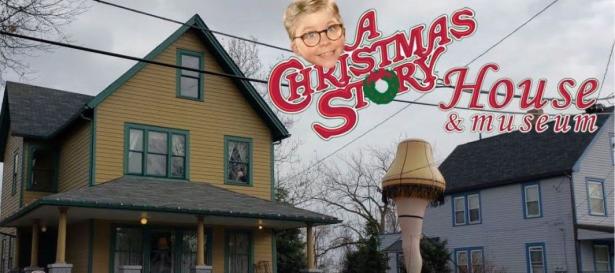If you have an extra 10 million dollars lying around, little Ralphie Parker’s house from A Christmas Story (1983), is for sale. The iconic mustard colored house, located on the outskirts of Cleveland, is currently owned by Brian Jones, a superfan of the film. Over the last twenty years, Jones has turned the fictional Parker homestead into a museum, hotel, and gift shop complex devoted to A Christmas Story. It’s a highly rated attraction that draws more than one million tourists per year!
Jones may have timed the sale of the house to coincide with A Christmas Story Christmas (2022), a sequel to the original film, which debuted on HBO Max in November. The sequel was co-written by Peter Billingsley, the actor who played Ralphie in the original. To save money, the film was made in Bulgaria! Now 51, Billingsley plays a grown-up Ralph who is trying to publish his first sci-fi novel, mourn the death of his father, comfort his mother, and give his wife and kids a decent Christmas. After the “old man” dies, Ralph brings his family to Hohman, Indiana, where he grew up, about an hour south of Chicago, circa 1973.
A Christmas Story Christmas has me thinking about some of the rules of the American Christmas Movie, and, especially, what kinds of stories we tell ourselves at Christmas about love, money, capitalism, and class.
Rule #1: American Christmas movies are big business based largely on repeats, spin-offs, and merchandise. A Christmas Story, according to Vanity Fair, started as a “low budget fluke.” It cost a paltry 3.3 million in 1983 and made nearly 20 million at the box office, but it was quickly forgotten. It became a sleeper hit when, in the 1990s, TNT and then TBS started running it as a Christmas Eve marathon. Today the Christmas Story universe is holiday gold for everyone who has a piece of the action. A stage production currently running in Pittsburgh is sold out. You can buy a full sized leg lamp, leg lamp Halloween costumes, leg lamp cookie cutters, and a statue of Flick with his tongue stuck on a pole. There is even merchandise related to this year’s sequel—a Blatz beer Christmas star. Fan love, and fan labor, are crucial to the meta-popularity of A Christmas Story, which you can see on this incredible Facebook page started by A Christmas Story actors.
Rule #2: In Christmas movies, we were all once working class – and we are still struggling financially. Set in 1940, A Christmas Story lovingly imagines a time when the typical American family had an icebox instead of a refrigerator, a monotonous nightly meal of red cabbage and meatloaf, a furnace that never worked properly, a car that frequently broke down, and a kitchen in which the family took most of its meals. In the sequel, we’re in the 1970s, and everyone is just barely getting by. Ralph’s boyhood friend Flick owns the Hohman town bar, and it’s full of working stiffs hiding from their families. His pal Schwartz is so hopelessly in debt to Flick that he must risk his life on a dangerous sledding dare in order to pay it off. Ralph’s broke status is self-imposed; he’s quit his job for a year to try to make it as a novelist. He has to break into Flick’s bar to get the Blatz Beer star for the top of his family’s Christmas tree, and his car is such a jalopy that the trunk won’t close and someone steals all the family’s Christmas presents.
While Christmas movies often begin with the struggles of being working class, they often end by reminding us that love matters more than stuff. In the original A Christmas Story, when Ralphie finally gets the Red Ryder BB gun, he nearly shoots his eye out — as everyone told him he would. The film ends with Ralph’s mom and dad enjoying a tender moment, happy even after the Bumpus hounds ruined Christmas dinner and Ralphie broke his glasses—a difficult item to replace for a family like theirs in 1940. As they watch the snow fall, the Christmas carol “Silent Night” plays in the background.
A Christmas Story and its sequel are mostly not sentimental—Santa and the elves are jerks, Ralphie and his dad are cursing fools, little brother Randy is weird and gross, and Ralph’s mom doesn’t stand up for herself in her marriage. But in this moment, we believe in this couple and in this family. All seems right with the world.
Rule #3: The American Christmas Movie rejects consumerism. The wealthiest characters in these filmsusually have the least access to love and happiness. In Elf, when Walter Hobbs has to meet with his boss on Christmas Eve, he realizes that the true meaning of Christmas is embodied by his son, Buddy, a bizarro Christ figure if ever there was one. For working-class characters, Christmas movies insist that focusing too much on presents is a problem – as we see Ralphie and his family don’t have a lot of stuff, and as a result, they have more love.
But love and stuff also come together in Christmas movies. In A Christmas Story Christmas, after the presents are stolen, Ralph’s old man saves the day from beyond the grave: before he died, he had purchased and wrapped Christmas presents for everyone and hidden them in the basement. As that plot line suggests, Christmas is “really” about love, but gifts can be a manifestation of love and connection.
As a radical activist who also loves Christmas, this can be a confusing time of year. I don’t love economic exploitation, but I do love Christmas. I love Christmas movies, too. They work to sell me stuff and ideology, but they also critique commercialism and exploitation. See what subversive messages you can find in a holiday classic. I triple dog dare you!
Kathy M. Newman


Spread the word